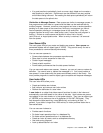fied as yes.) The retrieve API allows your application, in conjunction with alert fil-
tering, to perform user-defined actions based on the contents of the alert.
Node List API
A node list is either or both of the following:
A list of SNA nodes (network ID and control point name)
Internet protocol nodes (internet address or host name)
You can use node lists for grouping systems by any criteria that you may need for
your own applications. For example, the entries you put in a node list could be for
systems at a certain hardware level. The List Node List Entries (QFVLSTNL) API
is used to get the entries from the node list for use in your applications.
Registered Filter APIs
A filter is a function you can use to assign events into groups and to specify
actions to take for each group. The registered filter APIs allow a product to register
a filter with the operating system. The product can receive notification of events
recorded in a data queue by using the Send to Data Queue (SNDDTAQ) action of
the Work with Filter Action Entry (WRKFTRACNE) command.
A user filter is the filter defined by the network attributes for alert filtering and by the
system value for problem log filtering. A user filter and a registered filter differ in
their function and their notification record. There can only be one user filter active
at one time for each type of filter, but there can be multiple registered filters active
at one time. All actions are active for a user filter, but only the SNDDTAQ action is
active for a registered filter.
A product can use registered filter APIs for the following purposes:
To register multiple filters at the same time for each event type (alert or
problem log)
To deregister a filter when notifications from that filter are no longer necessary
To retrieve all the filters that are registered
The event notification record for a registered filter differs from notification records
for other types of filters. The registered notification contains a common header for
all events, as well as specific information based on the type of event. The common
header includes the name of the notification, a function type, a format, the filter
name and library, the group name, and a timestamp. The specific information for
the problem log includes the problem ID, the last event logged, and the timestamp
for the last event.
Change Request Management APIs
This group of APIs can be used to add, remove, and list activities and to retrieve
change request descriptions.
Object APIs
The object APIs consist of the following groups.
Chapter 8. Use of OS/400 APIs 8-11


















